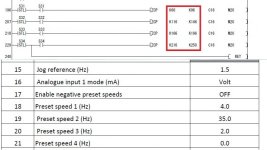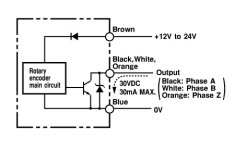Hi everybody,
I am new to the forum and I would like to ask apractical question about the issue I am experiencing in one of my projects.
Hopefully someone will be able to help.
I have a 220V motor which is used to travel a trolley over a certains distances over which I want to perform a certain number of stops. Usually it's 4 or 6 stops (incl start and end position).
I use FX - 1s - 10MR – ES for 4 Stops and FX - 1s - 14MR – ES for 6 Stops
The signal I am feeding as a reference rotation count is through double magnet switch on the rope pulley, with two magnets /so every rotation has two signals) and it's working pretty well.
I have, however, a problem in that that's not exactly precise. Sometimes it's stopping on the exact location as it should but sometimes (randomly) it's going for 0-20cm beyond or is that much short.
Now I am thinking to use a kind of an rotary encoder for that but as I do not have much experience I wanted to ask more knowledgeable ones which way to go.
So, I need the stops to be really precise, in let's say 1cm distance, which is possible, for sure.
Other way I was thinking of is to increase a number of signals (magnets on the pulley) to give a higher count number. Would that help?
Thanks in advance!
I am new to the forum and I would like to ask apractical question about the issue I am experiencing in one of my projects.
Hopefully someone will be able to help.
I have a 220V motor which is used to travel a trolley over a certains distances over which I want to perform a certain number of stops. Usually it's 4 or 6 stops (incl start and end position).
I use FX - 1s - 10MR – ES for 4 Stops and FX - 1s - 14MR – ES for 6 Stops
The signal I am feeding as a reference rotation count is through double magnet switch on the rope pulley, with two magnets /so every rotation has two signals) and it's working pretty well.
I have, however, a problem in that that's not exactly precise. Sometimes it's stopping on the exact location as it should but sometimes (randomly) it's going for 0-20cm beyond or is that much short.
Now I am thinking to use a kind of an rotary encoder for that but as I do not have much experience I wanted to ask more knowledgeable ones which way to go.
So, I need the stops to be really precise, in let's say 1cm distance, which is possible, for sure.
Other way I was thinking of is to increase a number of signals (magnets on the pulley) to give a higher count number. Would that help?
Thanks in advance!






